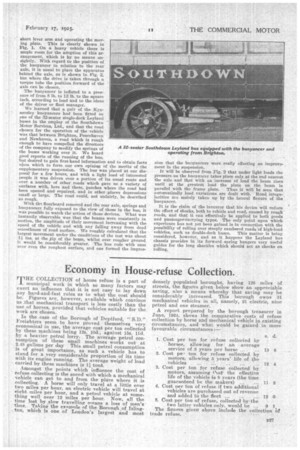Economy in House-refuse Collection.
Page 11

If you've noticed an error in this article please click here to report it so we can fix it.
rrIHE COLLECTION of house refuse is a part of J. municipal work in which so many factors may exert an influence that it is not easy to lay down any hard-and-fast rules as to what the cost should be. Figures are, however, available which convince us .that mechanical transport is less costly than the use of horses, provided that vehicles suitable for the work are chosen.
In the case of the Borough of Deptford, " S.D." Freighters seem to have proved themselves very economical in use, the average cost per ton collected by these machines being 12s. 10d., against 15s. 11d. by a heavier petrol lorry.. The average petrol consumption of these small machines works out at 2.48 gallons per day This small petrol consumption is of great importance, as such a vehicle has to stand for a very considerable proportion of its time with its engine running. The average weight of load carried by these machines is 14 tong. Amongst the points which influence the cost of refuse collecting is the speed with which a mechanical vehicle can get to and from the place where it is collecting. A horse will only travel at a little over two miles per hour, an electric vehicle will travel at eight miles per hour, and a petrol vehicle at something well over 12 miles per hour. Now, all the time lost by slow travelling means a loss of men's time. Taking the exam ole of the Borough of Islington, which is one of London's largest and Most densely populated boroughs, having 126 miles of streets, the figures given below show an appreciable saving, also a means whereby that saving may be considerably increased. This borough owns 31 mechanical vehicles in all, namely, 21 electric, nine petrol and one steamer.
A report prepared by the borough treasurer in June, 1924; shows the comparative costs of refuse collection by horse and mechanical vehicle in existing circumstances, and what would be gained in more favourable circumstances:—
s. d.
1. Cost per ton for refuse collected by horses, allowing for an average service of 8 years per horse ...8 2. Cost pe. ton for refuse collected b13 y motors, allowing 5 years' life of the
vehicles .....12 4
3. Cost per ton for refuse collected by motors, assuming Plat" the effective life of the vehicle is 8 years (the time
guaranteed by the makers) ... ... 11 2 4. Cost Der ton of refuse if two additional vehicles are purchased out of revenue
and added to the fleet ... ... 12 0
5. Cost per ton of refuse, collected by the
two latter vehicles only, would he ... 9 1 The figures given above include the collection Of trade refuse.
































